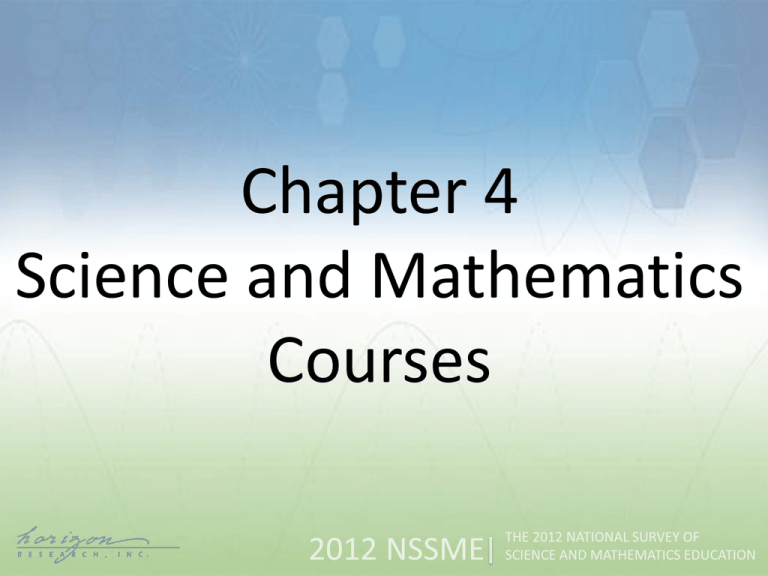Science - Horizon Research, Inc.
advertisement

Chapter 4 Science and Mathematics Courses SCIENCE Time Spent in Elementary Science Instruction Original Data for Slide 5 (not for presentation) Table 4.1 Frequency with Which Self-Contained Elementary Classes Receive Science and Mathematics Instruction, by Subject Percent of Classes Science Grades K–3 All/Most days, every week Three or fewer days, every week Some weeks, but not every week Grades 4–6 All/Most days, every week Three or fewer days, every week Some weeks, but not every week 20 39 41 (1.5) (1.5) (1.9) 35 33 32 (2.6) (2.6) (2.5) Frequency with Which Self-Contained Elementary Classes Receive Science Instruction Percent of Classes 60 39 40 20 41 35 33 32 20 0 Grades K–3 All/Most days, every week Some weeks, but not every week Grades 4–6 Three or fewer days, every week Original Data for Slide 7 (not for presentation) Table 4.2 Average Number of Minutes per Day Spent Teaching Each Subject in Self-Contained Classes,† by Grades Number of Minutes Grades K–3 Grades 4–6 Reading/Language Arts Mathematics Science Social Studies † 89 54 19 16 (1.7) (1.0) (0.5) (0.4) 83 61 24 21 (2.2) (1.4) (0.9) (0.8) Only teachers who indicated they teach reading/language arts, mathematics, science, and social studies to one class of students were included in these analyses. Average Number of Minutes Spent Teaching Subjects in Self-Contained Classes, by Grades 100 89 83 Number of Minutes 80 61 54 60 40 19 20 24 16 0 Grades K–3 Grades 4–6 Reading/Language Arts Mathematics Science Social Studies 21 Science Course Offerings Original Data for Slide 10 (not for presentation) Table 4.3 Type of Middle School Science Courses Offered, by Grade Single-Discipline Science Courses Only Coordinated or Integrated Science Courses Only Both Grade 6 36 (3.6) 45 (4.1) 19 (3.5) Percent of Schools Grade 7 46 (3.8) 38 (3.7) 15 (3.6) Grade 8 47 (3.8) 36 (3.7) 18 (3.5) Type of Middle School Science Courses Offered, by Grade Percent of Schools 60 40 20 47 46 45 38 36 19 36 15 18 0 Grade 6 Single -Discipline Grade 7 Coordinated or Integrated Grade 8 Both Original Data for Slides 12–18 (not for presentation) Table 4.4 High Schools Offering Various Science Courses Percent of Schools Biology/Life Science Any level Non-college prep 1st year college prep, including honors 2nd year advanced Chemistry Any level Non-college prep 1st year college prep, including honors 2nd year advanced Physics Any level Non-college prep 1st year college prep, including honors 2nd year advanced Coordinated or Integrated Science Courses (including General Science and Physical Science) Any level Non-college prep College prep, including honors Environmental Science/Ecology Any level Non-college prep 1st year college prep, including honors 2nd year advanced Earth/Space Science Any level Non-college prep 1st year college prep, including honors 2nd year advanced Engineering Any level Non-college prep 1st year college prep, including honors 2nd year advanced 98 73 89 64 (0.9) (2.7) (1.9) (3.4) 94 51 85 44 (1.8) (2.7) (2.5) (2.6) 85 37 77 34 (1.9) (2.9) (2.5) (2.2) 68 60 47 (3.2) (3.2) (2.8) 48 31 31 18 (3.2) (2.7) (2.4) (1.4) 48 41 25 4 (2.9) (2.9) (2.2) (0.8) 24 14 13 5 (2.1) (2.1) (1.5) (1.1) High Schools Offering Various Biology/Life Science Courses Percent of Schools 100 98 89 73 80 64 60 40 20 0 Any level Non-college 1st year prep college prep, including honors 2nd year advanced High Schools Offering Various Chemistry Courses Percent of Schools 100 94 85 80 60 51 44 40 20 0 Any level Non-college 1st year prep college prep, including honors 2nd year advanced High Schools Offering Various Physics Courses Percent of Schools 100 85 77 80 60 37 40 34 20 0 Any level Non-college 1st year prep college prep, including honors 2nd year advanced High Schools Offering Various Integrated Science Courses Percent of Schools 100 80 68 60 60 47 40 20 0 Any level Non-college prep College prep, including honors High Schools Offering Various Environmental Science/Ecology Courses Percent of Schools 100 80 60 48 40 31 31 18 20 0 Any level Non-college 1st year prep college prep, including honors 2nd year advanced High Schools Offering Various Earth/Space Science Courses Percent of Schools 100 80 60 48 40 41 25 20 4 0 Any level Non-college 1st year prep college prep, including honors 2nd year advanced High Schools Offering Various Engineering Courses Percent of Schools 100 80 60 40 24 14 20 13 5 0 Any level Non-college 1st year prep college prep, including honors 2nd year advanced Original Data for Slide 20 (not for presentation) Table 4.5 Access to AP Science Courses Percent of High Schools Offering AP Biology AP Chemistry AP Physics B AP Environmental Science AP Physics C 43 34 22 17 12 (2.8) (2.3) (1.8) (1.3) (1.2) Percent of High School Students with Access 74 67 48 38 25 (1.7) (1.8) (1.9) (2.0) (2.0) Access to AP Science Courses 100 80 74 67 AP Biology 60 48 43 40 38 34 22 20 AP Chemistry AP Physics B 25 17 AP Physics C 12 0 Percent High Schools Offering AP Env. Science Percent High School Students with Access Original Data for Slide 22 (not for presentation) Table 4.6 Number of AP Science Courses Offered at High Schools Percent of Schools† 0 courses 53 (3.1) 1 course 11 (2.1) 2 courses 10 (1.4) 3 courses 11 (1.4) 4 courses 10 (1.2) 5 courses 5 (0.8) † Only schools that responded about each AP science course are included in this analysis. Number of AP Science Courses Offered at High Schools 60 Percent of Schools 53 40 20 11 10 11 10 5 0 0 courses 1 course 2 courses 3 courses 4 courses 5 courses Original Data for Slides 24–26 (not for presentation) Table 4.7 Average Number of AP Science Courses Offered at High Schools, by Equity Factors Average Number of Courses Percent of Students in School Eligible for FRL Lowest Quartile Second Quartile Third Quartile Highest Quartile School Size Smallest Schools Second Group Third Group Largest Schools Community Type Rural Suburban Urban 2.0 1.5 1.1 1.1 (0.2) (0.3) (0.2) (0.2) 0.7 1.2 2.1 2.8 (0.1) (0.2) (0.2) (0.2) 0.7 1.7 1.7 (0.1) (0.2) (0.3) Average Number of Courses Average Number of AP Science Courses Offered at High Schools, by Percentage of Students in School Eligible for Free/Reduced-Price Lunch 3 2.5 2 1.5 2 1.5 1.1 1.1 1 0.5 0 Lowest Poverty Second Quartile Third Quartile Highest Poverty Schools Schools Quartile of Schools Based on Percentage of Students Eligible for Free/Reduced-Price Lunch Average Number of AP Science Courses Offered at High Schools, by School Size Average Number of Courses 3 2.8 2.5 2.1 2 1.5 1 1.2 0.7 0.5 0 Smallest Schools Second Group Third Group Largest Schools Quartile of Schools Based on School Size Average Number of AP Science Courses Offered at High Schools, by Community Type Average Number of Courses 3 2.5 2 1.7 1.7 Suburban Community Type Urban 1.5 1 0.7 0.5 0 Rural Original Data for Slide 28 (not for presentation) Table 4.8 Science Programs and Practices Currently Being Implemented in High Schools Percent of Schools Physics courses offered this school year or in alternating years, on or off site Concurrent credit/dual enrollment courses offered this school year or in alternating years Students go to a Career and Technical Education Center for science and/or engineering instruction Students go to a college or university for science and/or engineering courses Science and/or engineering courses offered by telecommunications Students go to another K–12 school for science and/or engineering courses 88 28 22 22 18 8 (2.9) (2.8) (3.2) (2.4) (2.9) (2.5) Science Programs and Practices Currently Being Implemented in High Schools Physics courses, on or off site 88 Concurrent credit/dual enrollment courses 28 Students go to college or university for instruction 22 Students go to Career/Technical Education Center for instruction 22 Science/engineering courses offered by telecommunications 18 Students go to another K–12 school for instruction 8 0 20 40 60 80 Percent of Schools 100 Other Characteristics of Science Classes Original Data for Slide 31 (not for presentation) Table 4.19 Prior-Achievement Grouping in Classes, by Subject and Grade Range Elementary Science Classes Mostly low achievers Mostly average achievers Mostly high achievers A mixture of levels 10 37 9 45 (1.3) (1.8) (1.1) (2.0) Percent of Classes Middle 14 33 13 39 (2.0) (2.0) (1.6) (2.3) High 13 30 28 29 (1.1) (1.3) (1.3) (1.4) Prior Achievement Grouping in Science Classes, by Grade Range Percent of Classes 60 45 39 37 40 33 20 10 14 9 30 28 29 13 13 0 Elementary Middle High Mostly low achievers Mostly average achievers Mostly high achievers A mixture of levels Original Data for Slides 33–34 (not for presentation) Table 4.23 Average Percentages of Female and Non-Asian Minority Students in Courses, by Grade Range and Course Type Science Non-Asian Female Minority Grades Elementary Middle High High School Science Courses Non-college prep 1st Year Biology 1st Year Chemistry 1st Year Physics Advanced Science Courses 48 46 49 (0.5) (0.7) (0.8) 39 36 31 (1.9) (1.6) (1.2) 46 49 51 49 54 (1.2) (1.6) (1.4) (1.8) (1.9) 36 33 30 23 21 (2.3) (2.7) (1.8) (2.7) (2.3) Average Percentage of Female Students in High School Science Courses, by Course Type Average Percent of Students 100 80 60 46 49 51 49 Non-college prep 1st Year Biology 1st Year Chemistry 1st Year Physics 54 40 20 0 Advanced Science Courses Average Percentage of Historically Underrepresented Students in High School Science Courses, by Course Type Average Percent of Students 100 80 60 40 36 33 30 23 21 1st Year Physics Advanced Science Courses 20 0 Non-college prep 1st Year Biology 1st Year Chemistry


